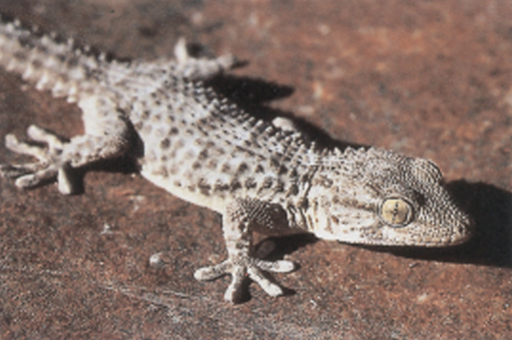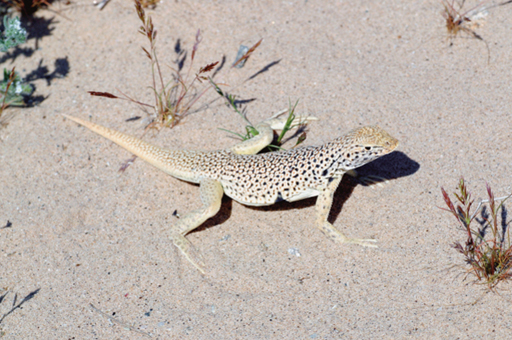Nocturnal Animals In The Desert
Nocturnal desert animals

Effigy _unit3.2.6 Figure 8 The Moorish gecko (Tarentola mauretanica)
A few desert reptiles are nocturnal; the Moorish gecko (Tarentola mauretanica), is found in arid regions in Northward Africa (also in Spain, France and Hellenic republic, and then information technology is not restricted to deserts).
Tarentola is well-nigh active for a few hours after sunset. During the night, itsT b is every bit low equally 18°C, and tin fluctuate by upwards to 11°C. Those lizards that tolerate wide fluctuations inT b, even when they could use features of the surroundings to maintain a steadyT b, are known as thermal generalists. The Moorish gecko is a thermal generalist at nighttime, when it is active rather than resting in its burrow. During the early on morning the Moorish gecko basks in the sunlight and its skin darkens until virtually black. At dark the gecko is very stake.
What functions and advantages do the changes in pare colour give?
Dark colours absorb and radiate rut ameliorate than low-cal colours. At night a light color should reduce heat loss by radiation, and in that location is not much heat available to absorb. During the twenty-four hours, dark skin promotes absorption of solar heat. Although radiation to the atmosphere past the dark peel is likewise promoted, the free energy and then lost is of piddling significance compared to the large amount of solar heat absorbed.
The advantage to the gecko of warming up in the morn is uncertain, simply it is possible that a physiological procedure such as digestion of the food eaten during the dark requires a higherT b than the gecko tin maintain at night.
The ability of the gecko to vary peel colour shows that behavioural thermoregulation in reptiles is supplemented by physiological mechanisms.
Sheltering in the bachelor shade in the desert, or beingness active at night, are uncomplicated strategies for keepingT b below lethal levels. In sandy desert areas, the sand itself plays an important role in behavioural thermoregulatory strategies. The Mojave fringe-toed cadger (Uma scoparia) is restricted to fine, wind-diddled sand, e.one thousand. in dunes, dry out lake beds and desert scrub in the Mojave desert. Burrows in sand collapse immediately or presently after the fauna has moved on, so animals buried in sand rely on air trapped between sand particles for animate.Uma is a 'sand-swimmer' and its dorsoventrally flattened trunk and shovel-shaped caput facilitate movement through the sand, which is especially of import when escaping from predators such as snakes and badgers.

Figure _unit3.2.7 Effigy 9 The Mojave fringe-toed lizard (Uma scoparia)
The eyelids are protected from sand past large eyelid fringe scales. The digits take large lamellar fringes, elongated scales, especially long on the hind feet, which enable the lizards to run at speed on the sand surface. Uma grows up to about 110 mm in length, and its action blueprint is diurnal, varying according to ambient temperature. In March and April Uma is active for short periods considering of the low spring temperatures in the Mojave. In summer, from May to September, the lizards are active during mornings and tardily afternoons, feeding on insects and plants. Sand-swimming lizards are also found in the Namib desert and include the wedge-snouted sand lizard (Meroles cuneirostris).
Nocturnal Animals In The Desert,
Source: https://www.open.edu/openlearn/ocw/mod/oucontent/view.php?id=97328§ion=_unit3.2.2.2
Posted by: davisonated.blogspot.com


0 Response to "Nocturnal Animals In The Desert"
Post a Comment